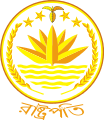A. Q. M. Badruddoza Chowdhury
| AQM Badruddoza Chowdhury একিউএম বদরুদ্দোজা চৌধুরী | |
|---|---|
| 13th President of Bangladesh | |
|
In office 14 November 2001 – 21 June 2002 | |
| Prime Minister | Khaleda Zia |
| Preceded by | Shahabuddin Ahmed |
| Succeeded by | Muhammad Jamiruddin Sarkar (Acting) |
| Personal details | |
| Born |
1 November 1932 Munsif Bari, Comilla, Bengal Presidency, British India (now in Bangladesh)[1] |
| Political party |
Bangladesh Nationalist Party (1978–2002) Bikalpa Dhara Bangladesh (2004–present) |
| Other political affiliations | Four Party Alliance (2001–2003) |
| Spouse(s) | Hasina Warda Chowdhury |
| Children | Mahi B. Chowdhury |
| Alma mater | Dhaka Medical College |
| Awards | Independence Day Award (1993) |
Abul Qasim Muhammad Badruddoza Chowdhury (born 1 November 1932) was the 13th President of Bangladesh, serving from 14 November 2001 until his resignation on 21 June 2002.[1] He was the founding secretary-general of Bangladesh Nationalist Party (BNP).[2]
He is also a noted physician, and former cultural activist, an author, essayist, playwright, television presenter and an orator of distinction.[1] He was awarded the National Television Award in 1976.
Early life
Chowdhury was born in his maternal grandfather's house in Comilla.[1] His paternal ancestors were from Majidpur Dayhata, Srinagar, Bikrampur (now Munshiganj District).[1] He passed his SSC from St Gregory's School in 1947 and HSC from Dhaka College in 1949.[3] He earned his MBBS degree from Dhaka Medical College in 1954–1955. His father Kafiluddin Chowdhury was a political leader of Awami League, a former general secretary of the United Front serving as Minister in the United Front provincial cabinet of the then East Pakistan. His mother is Sufia Khatun.
Medical career
Chowdhury started his career in the medical profession. He served as an Associate Professor of Medicine in Rajshahi Medical College in 1964 and Sir Salimullah Medical College during 1964–1970 and Professor of Medicine in Sylhet Medical College in 1970.[1] He served as the President of National Anti-Tuberculosis Association of Bangladesh (NATAB), President of International Union Against Tuberculosis of Lung Diseases (IUATLD) of Asia Pacific Zone.[1]
Political career
Being inspired by Ziaur Rahman, the founder chairman of the party, Badruddoza entered into politics as the Secretary General of BNP during its early years. He won the parliament election of 1979 as a BNP nominee from Munshiganj and served as cabinet minister during the years 1979–1982. When the BNP again won parliamentary elections in 1991, after a short stint as Education and Cultural Affairs Minister, he was appointed Deputy Leader of the House of Bangladesh parliament.
Presidency
Chowdhury was appointed the foreign minister of Bangladesh when BNP party came to power in 2001. In November 2001, he was elected the President of Bangladesh by Jatiyo Sangshad members. Seven months later the incident of him deciding not to visit BNP founder Ziaur Rahman's grave on his death anniversary provoked the party members.[2][4] They accused him of betraying the party. In June 2002 Chowdhury resigned from office as was asked by the ruling party before the situation could turn any murkier.[5]
Bikalpa Dhara
Chowdhury felt the need of a third force in the de facto two-party democracy in Bangladesh. He expressed recruiting civil society members in politics to fight corruption and terrorism and establish good governance in the country through an alternate stream (lit. Bikalpa Dhara) political party.[6] He, along with his son Mahi B. Chowdhury and BNP parliamentarian M A Mannan resigned from BNP to work for the new political party. Chowdhury was the President, with M A Mannan as the secretary-general of the new party, Bikalpa Dhara Bangladesh, formed in March 2004. It had been a strong critic of the government during the time, and most of its members were defects from the ruling BNP.[6]
For a brief period B. Chy. joined hands with senior statesman Dr. Col. Oli Ahmed Bir Bikram. Along with various senior Ministers from BNP cabinet they formed LDP - Liberal Democratic Party Bangladesh. This did not last and B. Chy. decided to come out of LDP & concentrate his efforts on reviving Bikalpa Dhara.
He has been the party's President since its inception, except for a brief period between December 2008[7][8] and April 2009,[9] during which time he had resigned from his post after the party could secure no seats during the 9th parliament elections.[8]
Personal life
Chowdhury is married to Hasina Warda Chowdhury.[10] Together they have a son, Mahi B. Chowdhury. Chowdhury resides in Baridhara neighbourhood in Dhaka.[10]
References
- 1 2 3 4 5 6 7 "AQM Badruddoza Chowdhury". Banglapedia. Retrieved 26 July 2015.
- 1 2 Habib, Haroon. "The sacking of a President". The Hindu. Retrieved 22 September 2011.
- ↑ Moshiul Alam (9 December 2012). "আপস-সমঝোতা ছাড়া গণতন্ত্র হয় না". Prothom Alo. Retrieved 9 December 2012.
- ↑ "Ghosts of presidents haunt Bangladesh politics". Daily News. 25 June 2003. Retrieved 22 September 2011.
- ↑ Chowdhury, Manosh. "Politics of Secularism in Bangladesh: On the Success of Reducing Political Vocabularies Into Evil 'Islamism". Jahangirnagar University. Retrieved 22 September 2011.
- 1 2 "RRT RESEARCH RESPONSE" (PDF). Refugee Review Tribunal, AUSTRALIA. Retrieved 22 September 2011.
- ↑ "Badruddoza, Mannan resign from party posts". The Daily Star. 1 January 2009. Retrieved 22 September 2011.
- 1 2 "Badruddoza resigns Bikalpadhara presidency". bdnews24.com. 31 December 2008. Archived from the original on 2 April 2012. Retrieved 22 September 2011.
- ↑ "Badruddoza Chowdhry becomes BDB chief again". The Daily Star. 9 April 2009. Retrieved 22 September 2011.
- 1 2 "Khaleda visits ailing B Chowdhury". bdnews24.com. 18 February 2014.
| Party political offices | ||
|---|---|---|
| New office | General Secretary of the Nationalist Party 1979–1990 |
Succeeded by Abdus Salam Talukder |
| Political offices | ||
| Preceded by Latifur Rahman |
Minister of Foreign Affairs 2001 |
Succeeded by Morshed Khan |
| Preceded by Shahabuddin Ahmed |
President of Bangladesh 2001–2002 |
Succeeded by Muhammad Jamiruddin Sarkar Acting |
